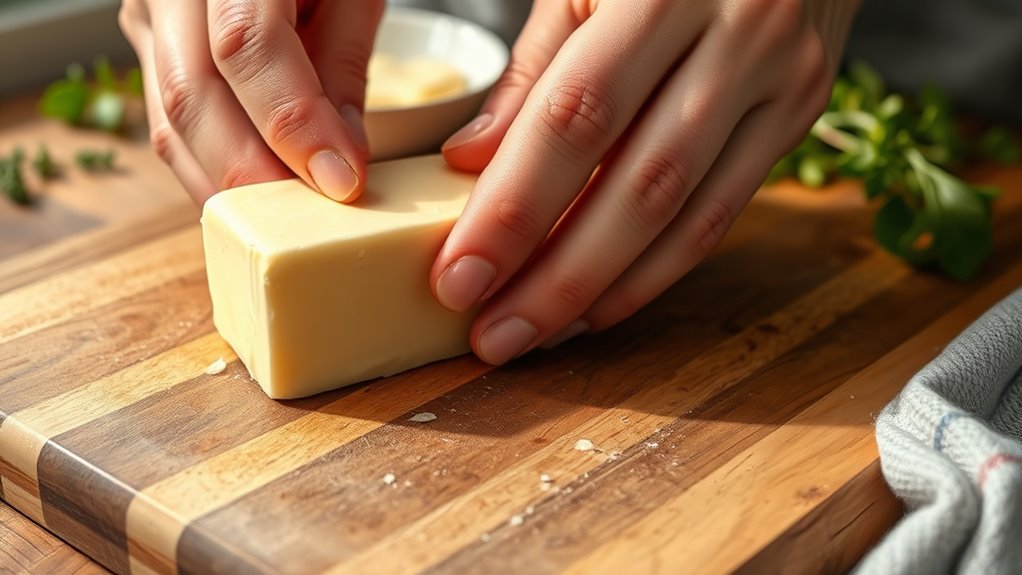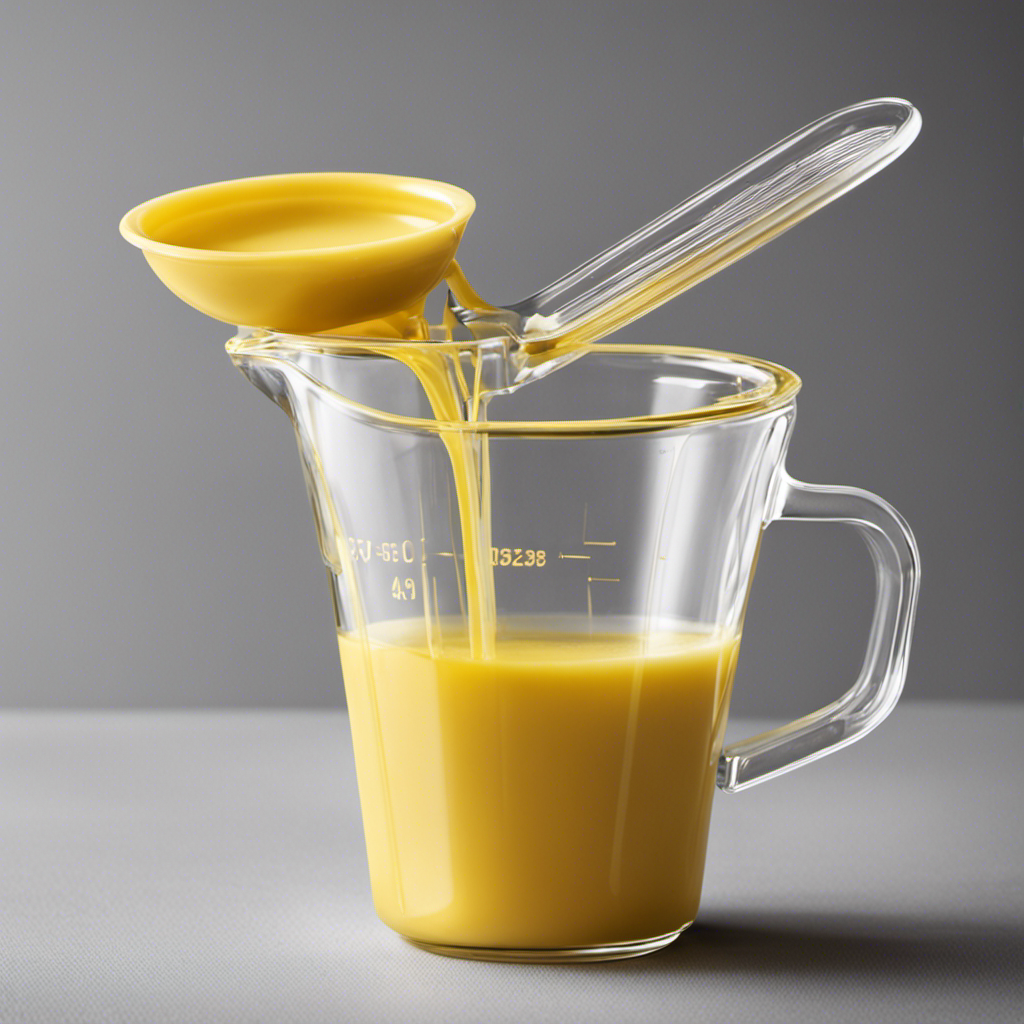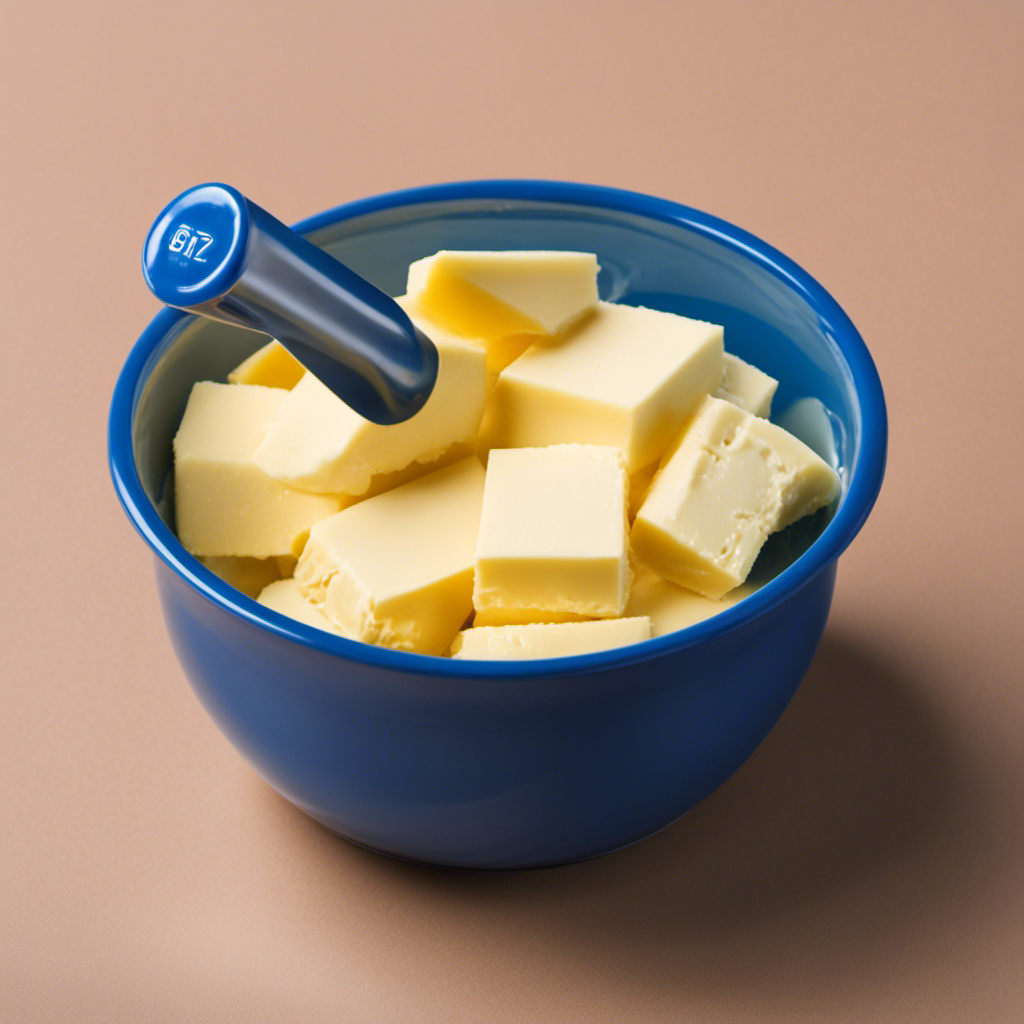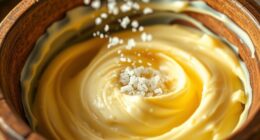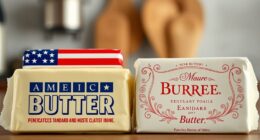To soften butter in 60 seconds without a microwave, try placing it in a warm water bath for gentle heat or flattening it into a thin, even layer to speed melting. You can also cut it into smaller pieces or roll it with a pin between parchment paper for quicker softening. Applying gentle heat with a hair dryer or wrapping it in a warm cloth works too. Keep experimenting; there are more effective tips if you continue exploring.
Key Takeaways
- Use a warm water bath: submerge sealed butter in warm water for a few minutes for quick, even softening.
- Flatten the butter block: press or roll it into a thinner shape to increase surface area and speed up softening.
- Cut into smaller pieces: slice butter into manageable chunks to facilitate faster softening through heat transfer.
- Apply gentle heat with a hair dryer: hold a low setting a few inches above butter, moving constantly for rapid softening without melting.
- Use a rolling pin: place butter between parchment or plastic wrap and gently roll to evenly soften in under a minute.
Using Warm Water Bath
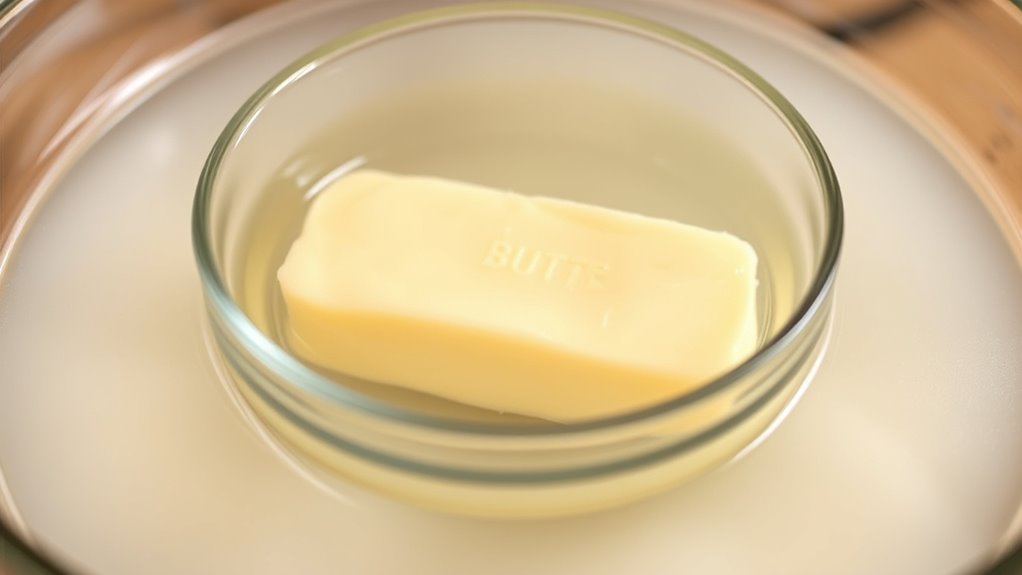
Using a warm water bath is an effective way to soften butter quickly and evenly. It’s especially helpful if your butter has been stored in the fridge and is too hard for baking or spreading. Fill a bowl with warm (not hot) water and place your butter, still in its wrapper or in a sealed plastic bag, into the bath. Wait a few minutes; the gentle heat will soften the butter without melting it. This method also allows for ingredient substitution: if you’re out of softened butter, you can soften it on demand without resorting to shortcuts that might affect the recipe. Just make sure you don’t let the water get too hot, as excessive heat can cause butter to melt or spoil its texture. Additionally, using a consistent temperature water bath ensures the butter softens uniformly without melting.
Flattening the Butter Block
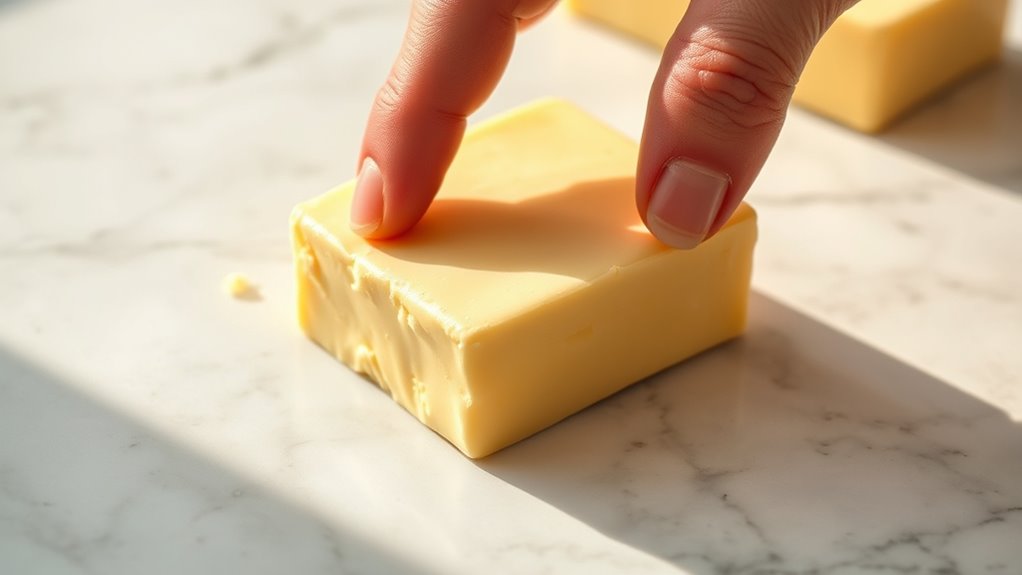
Flattening the butter block makes it easier to soften or incorporate into recipes. When you press the butter into a flat, even shape, you reduce its thickness and increase its surface area, helping it soften faster. Because butter density varies depending on storage techniques, flattening ensures consistent thickness regardless of whether it was stored in a block, stick, or wrapped. If your butter is cold or has been stored in the fridge, flattening can help it reach the desired softness more quickly. Use a flat surface or a rolling pin to gently press and spread the butter out. This method not only speeds up softening but also makes it easier to cut or measure accurately for recipes. Additionally, proper storage techniques can help maintain butter’s ideal texture and softness over time. Flattening is a simple step to improve your butter preparation process.
Cutting Into Smaller Pieces
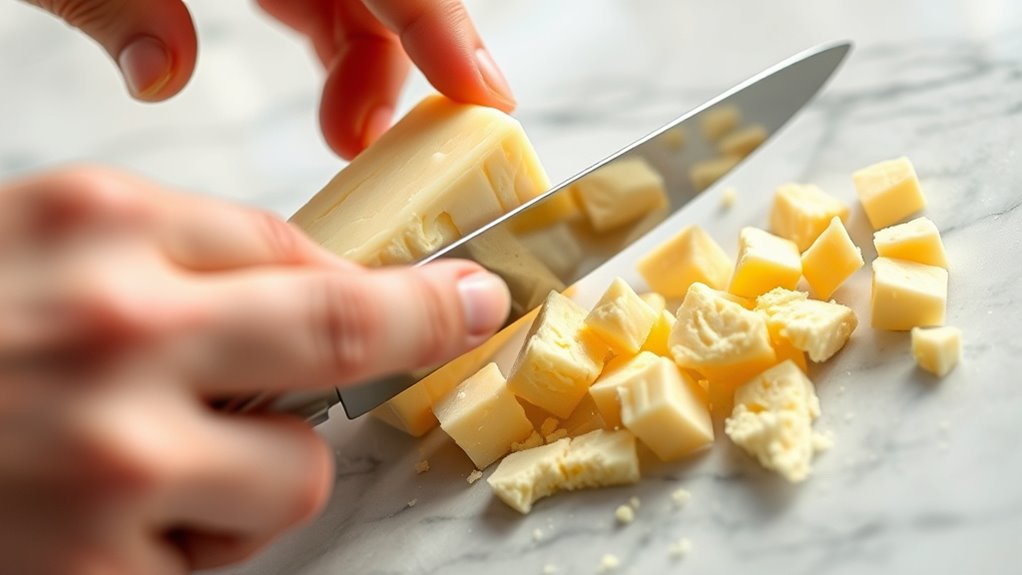
Breaking the butter into smaller pieces before softening speeds up the process and guarantees even warming. When you’re preparing to soften butter, consider how you store it—keeping it at room temperature makes slicing easier. Use proper knife techniques to cut clean, uniform pieces, which helps them soften evenly. A sharp knife minimizes crushing and ensures precise cuts, preventing uneven heating. If your butter is stored in a cold fridge, slicing into manageable chunks allows the heat transfer from your hands or ambient room temperature to reach each piece faster. Avoid smashing the butter; instead, use a gentle sawing motion to get consistent pieces. This method accelerates softening, saving you time and ensuring your butter is perfectly ready for baking or spreading. Proper storage of butter at room temperature also plays a crucial role in how quickly it softens.
Using a Rolling Pin
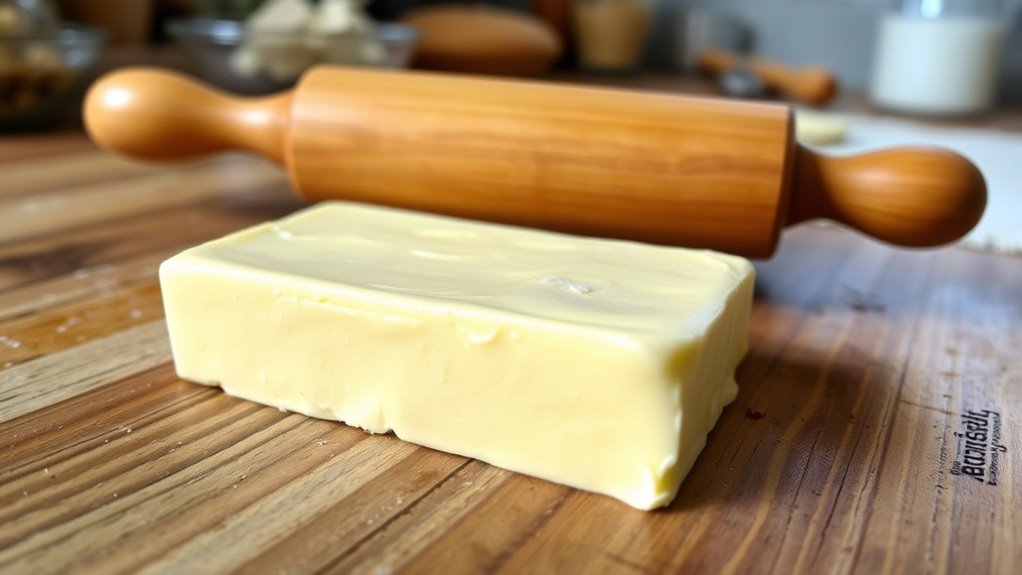
To soften butter quickly and evenly, a rolling pin can be a helpful tool. Place the butter between two sheets of parchment paper or plastic wrap to prevent tearing. Gently press and roll over the butter, spreading it evenly across its surface. This method helps achieve soft, uniform butter without melting it. Keep these tips in mind:
- Use a light touch to avoid tearing the paper or butter.
- Keep the butter chilled but soft enough to roll easily.
- Roll in different directions for even softening.
- Apply gentle pressure to spread the butter out.
- Check frequently, and don’t overwork the butter.
- Using a rolling pin can also help improve color fidelity by ensuring an even texture for better visual results in recipes.
Using a rolling pin ensures your butter softens uniformly, making it easier to blend into recipes or spread onto bread. It’s a simple, effective way to soften butter without heat.
Applying Gentle Heat With a Hair Dryer
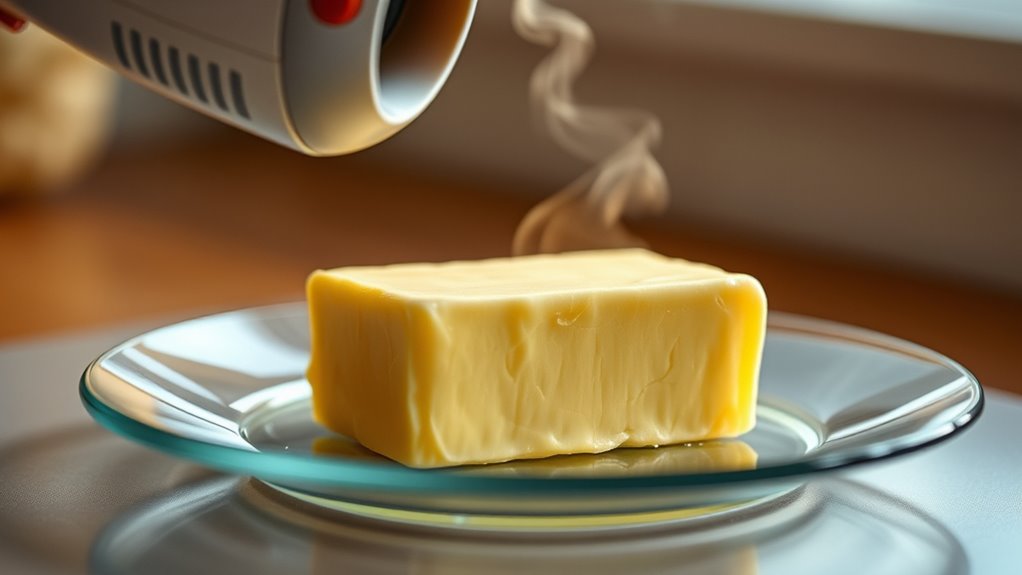
After using a rolling pin to spread the butter evenly, applying gentle heat with a hair dryer can further soften it quickly. Keep the dryer on a low, steady setting to prevent melting or uneven softening. Hold the dryer a few inches above the butter, moving it constantly to distribute heat evenly. This method works well with butter stored at room temperature or chilled, providing a quick alternative to waiting or using a microwave. Proper butter storage—preferably in a cool, dry place—ensures it softens uniformly and reduces the need for additional warming techniques. Using a hair dryer is an effective alternative method for softening butter when you’re in a hurry or want more control over the heat applied. Just be cautious to avoid overheating or melting the butter completely. Additionally, understanding AI security measures can help prevent accidental misuse of smart kitchen devices that might be integrated with AI systems.
Using a Warm Cloth Wrap
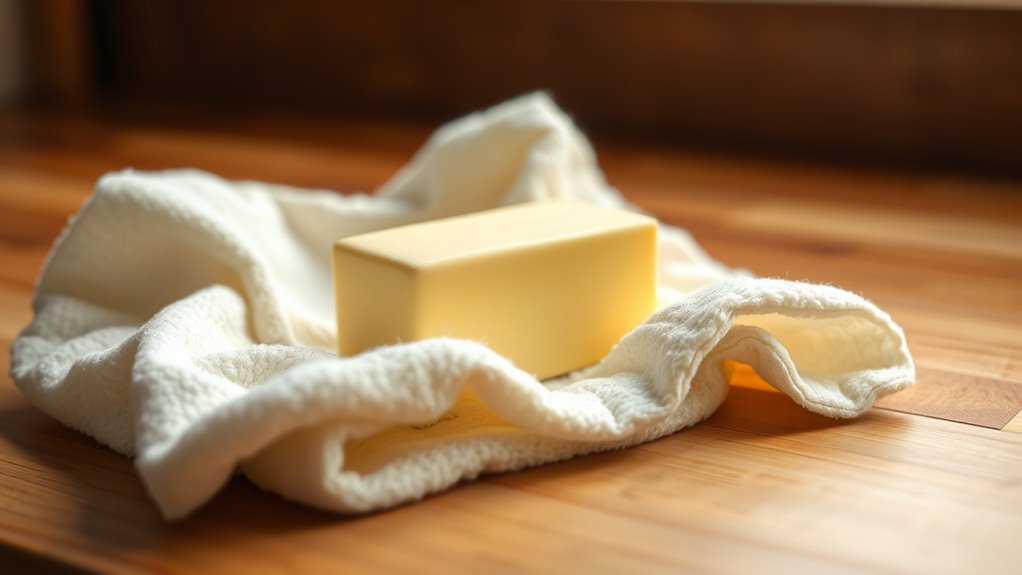
Using a warm cloth wrap offers a gentle way to soften butter without applying direct heat. It’s a safe, simple method that preserves proper butter storage and keeps your kitchen safe. To use this technique, wrap the butter in a clean, slightly warm cloth and leave it at room temperature for a few minutes. The cloth traps heat, gradually softening the butter evenly. Here are some tips to make it easier:
- Use a clean, dry cloth to prevent contamination
- Check the butter frequently to avoid melting
- Place the wrapped butter on a plate to catch drips
- Keep the butter away from heat sources for safety
- Don’t leave it out too long to prevent spoilage
- Incorporating kitchen safety practices helps prevent accidents during softening
This method ensures gentle, controlled softening without risking kitchen safety.
Employing the Stovetop Method
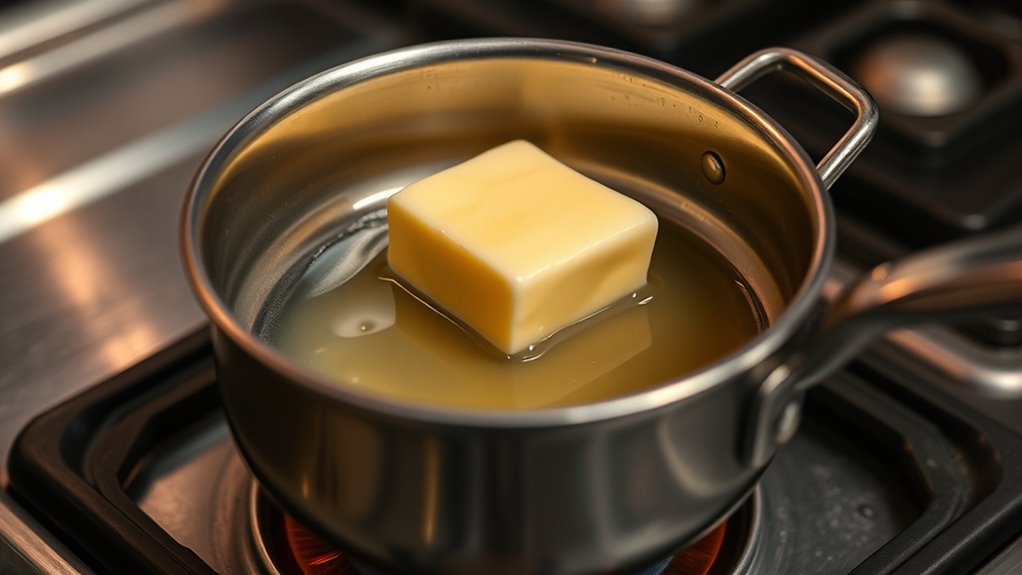
When softening butter on the stovetop, keep the heat low to prevent melting. Stir it constantly to guarantee even warming and avoid scorching. This simple approach helps you achieve perfectly softened butter quickly and safely.
Use Low Heat
To soften butter effectively on the stovetop, set your burner to the lowest heat setting. This allows for precise temperature control and ensures gradual warming without melting. Keep a close eye on the butter to prevent overheating. Using low heat helps you avoid sudden temperature spikes that could cause uneven softening or partial melting. Patience is key—allow the butter to warm slowly. You can also:
- Place the butter in a heatproof dish directly on the burner
- Cover it lightly to trap gentle warmth
- Check frequently to monitor softness
- Use small pieces for faster, even softening
- Remove it as soon as it’s pliable and soft enough to mix
This method gives you control, prevents over-softening, and keeps your butter perfectly ready. Employing controlled heat helps ensure the butter softens evenly without melting.
Stir Constantly
After setting your stovetop to low heat and placing the butter in a heatproof dish, begin stirring constantly as it warms. Stirring steadily prevents uneven melting and helps achieve a smooth, cream consistency. Keep your movements consistent to avoid hotspots that could burn or cause the butter to seize. As the butter softens, it becomes easier to mix, so stay attentive and keep stirring until it’s uniformly soft. Once the butter reaches your desired softness, quickly transfer it to your countertop placement for easy spreading. Don’t let it sit too long, or it might start to melt unevenly. Stirring constantly ensures a quick, even softening process, saving you time and keeping your butter perfectly creamy. Incorporating a protective styling method can help maintain the softened butter’s texture during application.
Frequently Asked Questions
How Can I Tell if the Butter Is Softened Enough?
You can tell if your butter is softened enough by gently pressing it with your finger. It should leave a slight indent without feeling greasy or overly firm. Softened butter reaches a temperature close to its melting point, making it easy to spread. If it’s still hard or too cold, give it a little more time at room temperature. Proper butter softness guarantees your recipes turn out perfectly.
Will These Methods Affect the Butter’S Flavor or Texture?
You wonder if these methods affect your butter’s flavor or texture. Generally, gentle softening methods won’t alter the butter aroma or cause significant texture changes. When you soften butter naturally, it retains its fresh flavor and smooth texture. However, if you overheat or use high heat, you might notice a slight aroma change and a softer, more spreadable texture. Stick to gentle techniques to preserve the butter’s original qualities.
Can I Soften Salted and Unsalted Butter Using These Techniques?
Did you know that softening butter can take up to 30 minutes at room temperature? You can soften both salted and unsalted butter using these quick methods, but beware of pasteurization concerns if you’re melting it too fast. For best results, follow storage tips to keep flavor and texture intact. These techniques work well for both types, ensuring your butter softens evenly without compromising quality or safety.
How Long Does Each Method Typically Take?
You wonder how long each method takes to soften butter. If you’re using room temperature or warm water, it can take about 5 to 15 minutes, depending on how cold your butter was stored. Using kitchen tools like a grater or rolling pin speeds up the process further. Keep in mind, proper butter storage helps maintain the right firmness, making softening quicker and easier without relying solely on time.
Are There Any Safety Precautions to Consider?
Imagine your kitchen as a safe haven where dairy safety is key. When softening butter, guarantee your utensils are spotless to prevent contamination. Avoid open flames or excessive heat, and handle the butter carefully to prevent burns. Keep your workspace dry and clean, and wash your hands thoroughly afterward. These precautions help protect your health and preserve the quality of your ingredients, ensuring a safe, enjoyable cooking experience.
Conclusion
So, next time you’re in a rush, think twice before reaching for the microwave. Did you know that warm water baths or a hair dryer can soften butter just as quickly? Some say it’s a myth that only heat melts butter, but these methods prove otherwise. Give them a try—you might find they work even better and save you from overmelting. Who knew softening butter could be so creative and quick?
